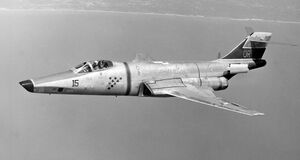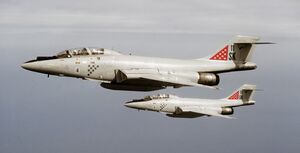KAD LLv.48-57
| LLv.48-57 Vengeance | |
|---|---|
 LLv.48-57/A No. 194 flying over Lake Kupalnitsa in first-generation livery, 1957. | |
| General information | |
| Role | Fighter Interceptor Strike aircraft |
| National origin | Ostrozava |
| Manufacturer | KAD Șomvor Ironworks Valegoria Industrial Concern |
| Primary user | Ostrozava |
| Service | Crimson Air Force Ostrozavan Aerospace Force Royal Air Force (Brumen) |
| Number built | 750+ |
| History | |
| Introduction date | 1957 |
| First flight | 1956 |
| In service | 1957-1980 (Ostrozava) 1960-1990 (Brumen) 19XX-19XX (Foreign) |
| Developed from | LLv. 48 |
The KAD LLv.48-57 Vengeance (Ostro-Ludzic: Trest) is an Ostrozavan twin-engine supersonic jet fighter. Designed and produced by the Crimson Aviation Workshop, it is best known as Ostrozava's first supersonic aircraft and the first jet fighter aircraft designed from the outset to use air-to-air missiles. Developed during the height of the Great Republican War, the 48-57 is a direct descendant of the smaller transonic LLv.48, and was developed in direct response to the Veldian XXXX and Velikoslav Fa-19 supersonic fighters which had proven far superior to the first-generation jets and superprops fielded by the Crimson Air Force since the late 1940s.
In 1955, with the Ostrozavan intervention in Rheigen underway, Alec Dalibor mandated the creation of the "Vengeance Fighter", which sought to achieve and surpass parity with rival fighter designs that had begun to be encountered in the skies over Rheigen and Veldia, and that could serve a secondary role as an effective interceptor against high-altitude strategic bombers. One of the Primar's explicit requests was that the aircraft be able to achieve supersonic speeds, and preferably above Mach 1.3, in order to be able to outrun all of its contemporaries. A design competition saw what would become the LLv. 48-57 prototype selected as the cheapest option for its performance, as it had been based on the existing LLv.48 airframe, unlike some of the more ambitious and expensive designs that had participated. Notably, the 48-57 was designed around the LZS-1 infrared air-to-air missile, which had been developed in 1955 by the Barderec Jet Works as the first operational component of the Vengeance program; while earlier applications of the LZS series missiles had been stopgaps, either mounted to transonic or subsonic jet aircraft or to superprops as a "last ditch" tactic, the 48-57 was intended to use these missiles from the outset and incorporated a fire-control radar and targeting computer.
The LLv.48-57 was developed in both single- and tandem-seat variations, and was upgraded significantly over its lifetime. Over 750 48-57s were built or converted from earlier airframes during active production; at the height of production in 1960, it is estimated that the KAD plant produced one and a half aircraft per day. Pilots flying the LLv.48-57 achieved over 100 aerial victories, and counted seven flying aces among their ranks. After the war, the 48-57 continued to be upgraded, with later variants able to launch radar-guided missiles and reach Mach 2.1 in level flight. It was widely marketed for export as the KAD Vengeance, where it served with Brumen, XXX, and XXX. In Ostrozavan service, the last 48-57s were retired in 1980, having been mostly relegated to a ground-attack and target-tug role in their final years of service.
Specifications
General characteristics
- Crew: 1 or 2
- Fuel capacity: 7,770 l (1,710 imp gal; 2,050 US gal) internals plus 2x optional 1,700 l (370 imp gal; 450 US gal) drop-tanks
Performance
- Maximum speed: Mach 1.72
- Thrust/weight: 0.74
Armament
- Missiles: 4-6 XXXX infrared air-to-air missiles or 4 XXXXX radar-guided missiles
Avionics
KAD Dandelion SRLv.56-20K combat air radar
Ioklos Fire Control System
